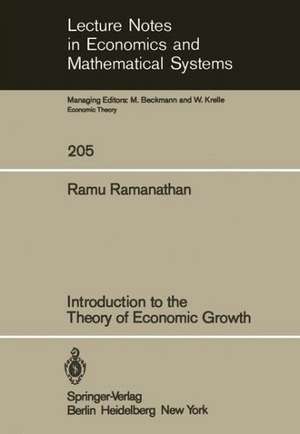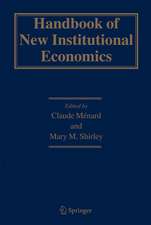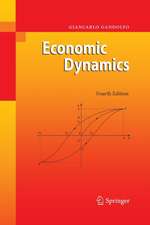Introduction to the Theory of Economic Growth: Lecture Notes in Economics and Mathematical Systems, cartea 205
Autor R. Ramanathanen Limba Engleză Paperback – 8 oct 1982
Din seria Lecture Notes in Economics and Mathematical Systems
-
 Preț: 360.02 lei
Preț: 360.02 lei -
 Preț: 383.93 lei
Preț: 383.93 lei -
 Preț: 384.09 lei
Preț: 384.09 lei -
 Preț: 380.07 lei
Preț: 380.07 lei -
 Preț: 446.26 lei
Preț: 446.26 lei -
 Preț: 497.37 lei
Preț: 497.37 lei -
 Preț: 380.84 lei
Preț: 380.84 lei -
 Preț: 384.86 lei
Preț: 384.86 lei -
 Preț: 378.34 lei
Preț: 378.34 lei -
 Preț: 399.67 lei
Preț: 399.67 lei - 20%
 Preț: 360.93 lei
Preț: 360.93 lei - 15%
 Preț: 643.16 lei
Preț: 643.16 lei -
 Preț: 379.09 lei
Preț: 379.09 lei -
 Preț: 404.74 lei
Preț: 404.74 lei -
 Preț: 385.62 lei
Preț: 385.62 lei - 15%
 Preț: 644.49 lei
Preț: 644.49 lei -
 Preț: 379.09 lei
Preț: 379.09 lei -
 Preț: 345.50 lei
Preț: 345.50 lei -
 Preț: 425.80 lei
Preț: 425.80 lei -
 Preț: 378.34 lei
Preț: 378.34 lei - 18%
 Preț: 775.65 lei
Preț: 775.65 lei -
 Preț: 392.60 lei
Preț: 392.60 lei -
 Preț: 401.61 lei
Preț: 401.61 lei - 15%
 Preț: 646.43 lei
Preț: 646.43 lei -
 Preț: 382.18 lei
Preț: 382.18 lei -
 Preț: 378.34 lei
Preț: 378.34 lei - 15%
 Preț: 637.59 lei
Preț: 637.59 lei - 15%
 Preț: 647.27 lei
Preț: 647.27 lei -
 Preț: 377.73 lei
Preț: 377.73 lei -
 Preț: 447.84 lei
Preț: 447.84 lei - 15%
 Preț: 644.49 lei
Preț: 644.49 lei -
 Preț: 386.00 lei
Preț: 386.00 lei - 15%
 Preț: 654.43 lei
Preț: 654.43 lei -
 Preț: 415.02 lei
Preț: 415.02 lei -
 Preț: 411.54 lei
Preț: 411.54 lei -
 Preț: 398.92 lei
Preț: 398.92 lei -
 Preț: 398.92 lei
Preț: 398.92 lei -
 Preț: 392.75 lei
Preț: 392.75 lei - 15%
 Preț: 635.47 lei
Preț: 635.47 lei - 20%
 Preț: 653.56 lei
Preț: 653.56 lei -
 Preț: 379.86 lei
Preț: 379.86 lei -
 Preț: 495.46 lei
Preț: 495.46 lei -
 Preț: 447.99 lei
Preț: 447.99 lei -
 Preț: 378.71 lei
Preț: 378.71 lei - 15%
 Preț: 637.13 lei
Preț: 637.13 lei -
 Preț: 385.84 lei
Preț: 385.84 lei -
 Preț: 378.54 lei
Preț: 378.54 lei - 15%
 Preț: 666.55 lei
Preț: 666.55 lei -
 Preț: 380.07 lei
Preț: 380.07 lei
Preț: 395.09 lei
Nou
Puncte Express: 593
Preț estimativ în valută:
75.61€ • 78.11$ • 62.93£
75.61€ • 78.11$ • 62.93£
Carte tipărită la comandă
Livrare economică 26 martie-09 aprilie
Preluare comenzi: 021 569.72.76
Specificații
ISBN-13: 9783540119432
ISBN-10: 3540119434
Pagini: 364
Ilustrații: X, 350 p.
Dimensiuni: 170 x 244 x 19 mm
Greutate: 0.58 kg
Ediția:Softcover reprint of the original 1st ed. 1982
Editura: Springer Berlin, Heidelberg
Colecția Springer
Seria Lecture Notes in Economics and Mathematical Systems
Locul publicării:Berlin, Heidelberg, Germany
ISBN-10: 3540119434
Pagini: 364
Ilustrații: X, 350 p.
Dimensiuni: 170 x 244 x 19 mm
Greutate: 0.58 kg
Ediția:Softcover reprint of the original 1st ed. 1982
Editura: Springer Berlin, Heidelberg
Colecția Springer
Seria Lecture Notes in Economics and Mathematical Systems
Locul publicării:Berlin, Heidelberg, Germany
Public țintă
ResearchCuprins
1. Introduction.- 2. Review of Production functions and their properties.- 2.1 Production with Fixed Coefficients.- 2.2 Substitution Between Capital and Labor.- References.- Exercises.- 3. Basic Neo-Classical growth models.- 3.1 The Harrod-Domar Model.- 3.2 The Solow-Swan Model.- 3.3 Summary.- References.- Exercises.- Appendix: Differential Equations.- 4. Technical Progress.- 4.1 Neutral and Non-Neutral Technical Change.- 4.2 Endogenous Technical Progress.- 4.3 Induced Bias in Technical Change.- 4.4 Embodied Technical Progress: Vintage Models.- 4.5 Measurement of Technical Change.- 4.6 Summary.- References.- Exercises.- 5. Money and economic growth.- 5.1 Tobin’s Model.- 5.2 Money as a Consumer Good.- 5.3 Money as a Producer Good.- 5.4 The Keynes-Wicksell Approach.- 5.5 A Synthesis of Neo-Classical and Keynes-Wicksell Models.- 5.6 Summary.- References.- Exercises.- 6. Neo-Classical models with two income classes.- 6.1 Different Saving Propensities for Workers and Firms.- 6.2 Wage Earners Receiving Dividend Income Also.- 6.3 The Pasinetti Paradox in a Two-Class Monetary Growth Model.- 6.4 Summary.- References.- Exercises.- 7. Cambridge growth models.- 7.1 A Simple Kaldorian Model.- 7.2 A Neo-Keynesian Model with Pasinetti Saving Behavior.- 7.3 The Technical Progress Function.- 7.4 Robinson’s Criticisms.- 7.5 Summary.- References.- Exercises.- 8. The speed of adjustment in growth models.- 8.1 The Solow-Swan Model.- 8.2 A Model With Unemployment.- 8.3 Other Models.- References.- Exercises.- 9. Optimal Growth.- 9.1 Inter-temporal Optimization.- 9.2 Economic Interpretations.- 9.3 Phase Diagram Analysis.- References.- Exercises.- 10. Two sector growth models.- 10.1 The Static Two-Sector Model.- 10.2 The Dynamic Two-Sector Model.- 10.3 Stability of the Long-runEquilibrium.- 10.4 Extension to the Case of Variable Savings Ratio.- References.- Exercises.- 11. International Trade and Economic Growth.- 11.1 A Static Two-Sector Trade Model.- 11.2 A Dynamic Two-Sector Trade Model.- 11.3 A Monetary Growth Model of an Open Economy.- References.- Exercises.- Review Questions.












